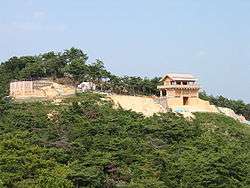Kingdom of Kibi

Kibi (吉備国 Kibi no kuni) was a kingdom of fourth century Western Japan that acted as a cultural bridge between the Yamato state and the various kingdoms of the Korean peninsula. The Kingdom of Kibi covered most of what is today Okayama Prefecture. Today, the Kibi Road crosses the plain between Okayama and Soja, what was once the heartland of Kibi-no-kuni.
Kibi was strategically located on the inland seaway between Korea and Yamato. The kingdom's strong influence on the Yamato administration, and the presence of Korean noblemen in the government of the ancient kingdom, would cause a chain of events that ended with the disintegration of Kibi.
Etymology
Though in the modern Japanese language the word kibi refers to millet, the name of the kingdom Kibi, which appears in the Kojiki and in the Nihonshoki (the oldest written records in Japan), likely has a different origin, which has been lost to time. Furthermore, the Chinese characters used for writing the word, which have been in use for over 1200 years, have nothing to do with millet.
Legendary Kibi
Kibi has been associated with the legends of Kibitsuhiko-no-mikoto, the son of Emperor Kōrei, who fought the ogre "Ura" and was enshrined as a god. Ura was said to have lived in Ki castle near the city of Sōja.
Historical Kibi
Archaeological research of many temples and shrine ruins, as well as burial mounds, suggests that the ancient kingdom was as developed and powerful as the Yamato administration that controlled Japan in the eighth century. The center of power of the Kibi Kingdom was located on the Kibi plain between Soja and Okayama.
The evidence of Kibi's importance in the fourth and fifth centuries is proven by the hundreds of kofun (tumuli) found in the area. A hereditary and aristocratic social structure followed more the Korean and Japanese sophisticated form of society, than the Chinese ways. Even after Kibi was subjugated, the descendants of Kibi's chieftains remained very influential.
In the Yayoi period, Kibi had great influence in local matters. Kibi was situated in a strategic point between the Tsukushi tribes of the south and the Kinki tribes of the east, controlling all the flow of vital supplies in the area.
References
- Gorman, Michael S.F. (1999). The Quest for Kibi. Orchid Press. ISBN 974-8299-23-6.
- Brown, Delmer (1993). The Cambridge History of Japan 6 Volume Set: The Cambridge History of Japan: Volume 1. Cambridge University Press. ISBN 978-0-521-22352-2.
